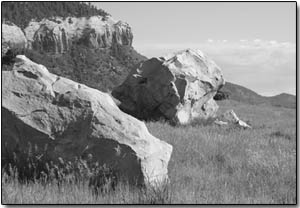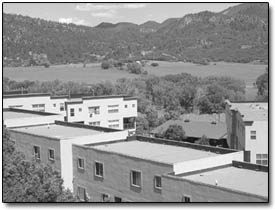 |
| Boulders catch the early morning
sun on public land near Falls Creek. While this land will
dodge development, hundreds of thousands of La Plata County
acres are vulnerable to the current growth boom./Photo by
Todd Newcomer |
In the midst of the largest swell of growth
and development in the Durango area’s history, a struggle
is under way to keep some land as it is today – empty.
Though efforts to preserve area open space have made great strides
in recent years, they currently face an uphill battle. And as
development proposals outpace conservation easements, land trusts
and officials are searching for new ways to keep some land subdivision-free.
To date, the La Plata Open Space Conservancy has helped preserve
13,813 acres in La Plata County. The majority of this acreage
has been voluntarily put into conservation easement, a binding
contract that forever prevents development from occurring on
the land. While nearly 14,000 acres of preserved property seems
impressive, Kathy Roser, executive director of the conservancy,
said there is still a long way to go.
“When you look at the big picture, it’s just a
drop in the bucket,” she said.
Still, she added that many significant parcels in key locations
have come under preservation, making for a somewhat hopeful
picture. “When you look at some of the projects that have
been completed and where they’re located, it’s significant.”
A growing list
The conservancy now has 45 projects on the to-do list, and
this-ever growing number represents completely voluntary deals
in which the landowner reaps only tax benefits. “Back
in the ’90s, we went for a couple years without completing
a single project,” Roser said. “We’re doing
between 15 and 20 a year now.”
Reasons to preserve open space range across the board, according
to Roser. “There are a million reasons of course,”
she said. “It provides many, many benefits, and they’re
not just pie-in-the-sky. They’re very real, including
everything from food production to wildlife habitat.”
Recently, the conservancy has helped facilitate conservation
easements of several key agricultural parcels in the southeast
corner of the county. “Some of the most significant ones
we’ve done recently were on farmland,” Roser said.
“Those easements are now furthering local agriculture,
which is hurting. In one case, we had a landowner take his tax
credits and buy more land to make his operation more viable.”
However, Roser acknowledged that thousands of units are currently
awaiting approval by city and county officials and growth has
become an issue afflicting the entire county. “Typically,
our efforts have focused on the river valleys,” she said.
“That’s where the best land is for agriculture,
wildlife and also development. But now, I think every place
is threatened. We’re seeing a lot more development pressure
in unusual places like the Dry Side.”
Roser said an unusual baby boom twist makes open space preservation
even more paramount. “More than half of all the land in
Colorado is government owned,” she said. “More than
half of what’s left is owned by people over 55. That land
is going to be changing hands in coming years.”
Under the gun
The sentiment that time is running out is shared by Tami Graham,
land trust coordinator with the Animas Conservancy. A relatively
new land preservation organization, the Animas Conservancy started
in 2000 and now holds 12 voluntary easements for a total of
492 acres.
“I think we’re under the gun of development and
growth, and we should all be very concerned with how we address
it,” she said.
Graham continued, “This area’s going to continue
to have growth demands. That’s not going to change. But
I think it’s happening so fast.”
Like Roser, Graham acknowledged that business has never been
better for local land trusts. She credited that progression
largely to state rather than local policy.
 |
The Pear Tree condos overlook
the River Trails Ranch in the Animas Valley. Area land trusts
are struggling to keep up with the volume of current development
proposals. River Trails Ranch has proposed building 800
units on this vacant land immediately north of Durango.
/Photo by Todd Newcomer. |
Specifically, she noted a change last fall whereby landowners
can now realize up to $260,000 in tax credits, well up from
a previous cap of $100,000. She also related a change in state
law two years ago, allowing landowners to sell tax credits at
80 cents on the dollar and actually reap some direct cash benefit
for conservation easements.
“Colorado has some of the best tax credits available
to private landowners...and that improved last fall,”
Graham said. “So on the one hand, we’re busier than
ever, but it’s difficult for a nonprofit land trust to
keep up with these levels of growth.”
Consequently, both Graham and Roser said that the entire country
needs to start exploring other solutions. Citing voluntary conservation
easements, Roser said, “I look at what we do as one tool
in the tool box. I hope at some point, sooner rather than later,
some other tools will come into play. One possible tool is government
regulation, and I feel like it’s been under-utilized or
not utilized at all.”
A look at the rulebooks
Within La Plata County’s land use regulations, open space
is an encouraged standard, and most of the plans for the county’s
districts offer density bonuses for clustering. County Planner
Nancy Lauro also noted that the county’s requirement of
3 acres per home provides a different brand of open space.
“It’s all relative,” she said. “When
you’re talking about one home per 3 acres, there’s
a lot of open space on that lot.”
The county also is reassessing its approach to encouraging
open space as it works on revising its land use regulations.
Robert Bowie, director of current planning, said that the county’s
open space regulations are “still evolving.”
“I don’t know that it’s working or to what
extent,” he said. “Part of the code revision will
look at whether current encouraged standards should be made
required standards or just dropped.”
The city of Durango has taken a proactive approach to open
space acquisition, particularly with the recent creation of
the Durango Open Space Advisory Board. The citizens’ group
had its first meeting in March and has been getting together
once a month with a goal of implementing the city’s Open
Space Master Plan.
Kevin Hall, the city’s Parks, Open Space and Trails development
manager, remarked, “What essentially the plan does is
talk about some of the important environmental values residents
wanted to target at the time.”
Looking back at projects like the 271-acre Durango Mountain
Park and the Animas River Trail, Hall said that the city’s
open space record is a strong one. He added that the large projects
are particularly successful given that the city has no direct
funding source for open space.
“I would say the city has been very successful considering
there’s no dedicated funding source and only a willing
council and public,” Hall said.
As the advisory board looks to the future and potential acquisitions
in and around the city, dollars will be paramount, according
to Hall. “The Open Space Advisory Board has really made
it clear that their immediate task is to identify funding sources
and permanent funding sources,” he said.
Forging new tools
Meanwhile, a joint effort by county, city and citizens is plowing
ahead. Since last fall, a working group has been studying an
open space tool known as transferable development rights (TDRs).
In brief, TDRs would enable the preservation of threatened areas
by concentrating density in areas earmarked for development.
Property rights would be bought in “sending areas,”
parcels designated as vital open space. Developers would then
be able to take these rights to urban, “receiving areas”
and develop density in excess of regulations. Like efforts to
date, TDRs would be voluntary and incentive based.
Durango City Planner Greg Hoch explained that City Council
members and county commissioners have put the onus on the working
group. If it can come up with an acceptable program, TDRs will
likely become another tool in the open space tool box.
“The general direction we received from the majority
of both elected bodies is to see if we could make this happen,”
Hoch said. “They told us they would decide if they can
go with it once we’ve got it worked out.”
Graham and the Animas Conservancy has been involved in the
process and applauded it. “I think it’s a great
model for citizens and officials working across municipal and
county lines to form a plan,” she said.
Stacy Patton, a former planner and current consultant to the
county Planning Department, is optimistic that TDRs will be
adopted. “It’s absolutely a viable tool for the
county,” she said.
Currently, the discussion has become highly technical, and
Patton noted that there have been concerns over whether TDRs
will fit with the Southern Ute Indian Tribe’s proposal
for 2,500 units in the Grandview area.
“We’re still getting some who are concerned that
the Grandview plan will be dense enough without TDRs,”
she said. “We’re convinced it will work in some
capacity at Grandview, and if not, it will be a good program
for the rest of the county.”
However, the TDR working group plans on reaching a conclusive
end prior to July 17, when a tentative public presentation is
planned.
In the meantime, the La Plata Open Space Conservancy and Animas
Conservancy are busying themselves with education in an effort
to inform landowners that conservation is not a takings and
can be beneficial.
“Where we are challenged is in educating people that
this can be progress and that there are benefits,” Roser
said.

